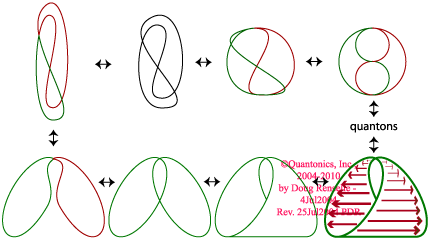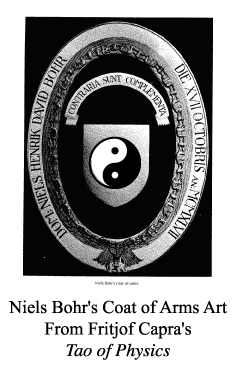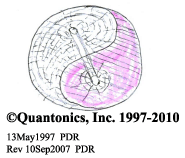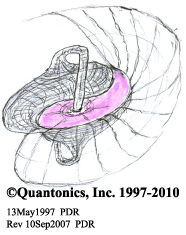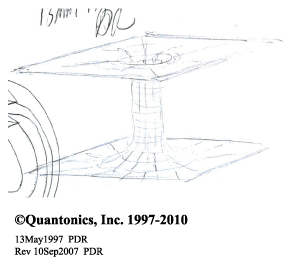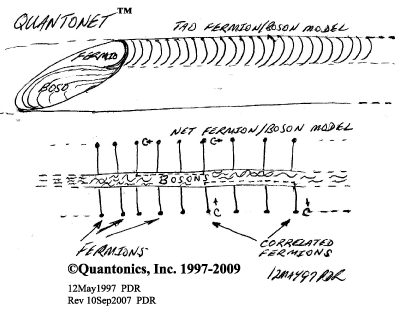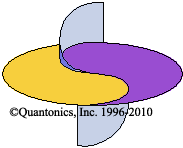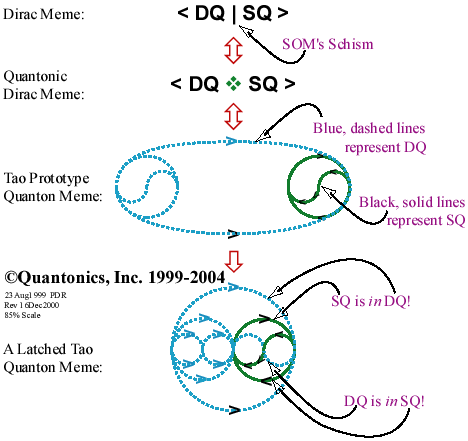|
|
|
|
||||||||||||||||||||||||||||||||||||||
|
Aug 1999 |
What does all this have to do with yin and yang? |
Carla Park from Australia answers on 17Aug1999: Old and new;
As strands of thought have evolved the shortcomings of the previous
manner of distinguishing between the phenomena collectively named
reality have become apparent
so dynamic insights are trying
to incorporate themselves into the static
structure of 'recognized' philosophy
so as to define and utilize terms which offer more accurate descriptions
as to the structure and nature of reality. Thus the divergent
and convergent nature of the discussion and the agreement and
disagreement between the static
body of thought and the dynamic
insights trying to offer greater clarity to the Questions traditionally
wrestled with, to me resemble the nature of 'yin and yang', moving
forward with balance. — Thanks, Carla, for participating in our Quantonics Question & Answer for August, 1999! Your answer is superb. It grasps essence of Pirsig's MoQ from an alternate perspective. I consider memetic concord such as this — a kind of philosophical overlapping of similar attractors — a kind of co-validation. However, meme 'yin and yang' is different. It is more quantum-rhetorical than classical-dialectical. We enjoyed your answer. Please share again. We have several questions about your philosophical view: 1. Do stasis and dynamis superpose? Doug. Beth answers on 25Aug1999: Dugger, What does all of this have to do with yin and yang? I have not read much detail about yin and yang, but I will
take a stab Autonomous and yet coexist. Well, am I on the right track? (Quantonics color and emphasis added. 26Aug1999 PDR.) — Thanks Beth, for participating in our Quantonics Question & Answer for August, 1999! As usual, you pretty much hit bulls' eyes. From my personal perspective you state essence as your answer. Please note my questions above to Carla. Thanks again for participating in our August QQ&A. Doug.
|
||||||||||||||||||||||||||||||||||||||
|
Doug's response to our August, 1999 Question: "What does all this have to do with yin and yang?" We want to use some acronyms in our answer:
We want to use two symbols in our answer:
(Use your right mouse button to click on our 'quantonic equals' to see its GIF art.) Please be aware there are many ways to approach Tao. There are various cultural interpretations including Japanese, East Indian, Chinese, etc. We chose China's I Ching for our approach to Tao. We are using, as our source of information about Tao and yin/yang, a fine book titled, I Ching, by Rudolph Ritsema and Stephen Karcher, pub. Barnes & Noble Books, 1995. We find this book simply superb! Even if you may not become a practitioner of I Ching, you will find this book a fun adventure. Its generous and general contexts and examples allow you to shine alternate light on your own life and its unique questions and issues. Note that we are not experts on I Ching. Honestly, you may say we are not even novices! We are reading this book and putting its words and concepts in interrelationships with other work we do here in Quantonics. Please keep that in mind as you read our words here. Delightfully, we find extraordinary resonances among: Pirsig's MoQ, Quantonics, Quantum Science, and I Ching's Tao. We pursue those harmonies in our answer to August, 1999's Quantonic Question & Answer, "What does all this have to do with yin and yang?" (Too, our opinions find a few dissonances, which we note.) Ching means standard, fundamental, classic text. I has three themes. Tao is one theme. Two other I themes are: te (power/virtue), and chün tzu (divine living via connection to Tao). Chün tzu is roughly equivalent to what we call 'interrelationships'
in Quantonics. Chün tzu is 'superposition' of nonactual/actual
(I Ching says, "...heaven/earth"). Our symbol '
Described in words, i.e., how did we transmogrify reality models from I Ching to Quality? We replace:
Tao is literally: way; flow of energy. (Compare Tao to Wu Li, or patterns of energy, i.e., 'physics.' Note Gary Zukav depicted five of over 85 possible interpretations of Wu Li in his Dancing Wu Li Masters: Patterns of Organic Energy, My Way, Nonsense, I Clutch My Ideas, and Enlightenment. Ritsema and Karcher's I Ching appears to use 'Wu' as 'no' consistently. This appears as one potential weakness. Also note that we depicted Tao as more like MoQ's DQ. DQ has no patterns — it is patternless, absolute change. Patterned energy is part of MoQ's SQ. So you can see our comparisons are inexact.) Tao has no English equivalent. One seeks to be in Tao (both/and
Tao 'seeks' to be in one) and thus experience enlightenment and
life's ('reality's') energy. Tao Tao is implicit/intrinsic/natural coherence. We could use our Quantonic notation to represent I Ching slightly differently: I Ching I Ching offers detail for answers, understanding and enlightenment via an organization of 64 hexagrams. We want to give a brief description of a hexagram, and then look briefly at Tao's yin and yang through each of 64 hexagrams. Each hexagram is an answer to one of your questions. One examines self in light of a hexagram, with one's full awareness a hexagram represents a c¤mplementary pair: trial (testing of self) and vessel (containment, innovation, imagination, sustenance, support, transformation). Here is what Ritsema and Karcher have to say about I Ching's hexagrams: "Each hexagram is made up of six opened — — and/or whole ——— lines. The lines have specific qualities, called supple and solid, which link them with the two primary agents in Eastern thought, yin and yang. Each hexagram can be thought of as a set of six empty places through which energy moves and changes. Energy comes into the hexagram from below [line 1] and leaves at the top [line 6]. The places are numbered accordingly. The lowest is the first and the highest is the sixth. These hexagrams represent possible modes of change in the world, the dynamic qualities of time. "Each hexagram is also thought of as being composed of two trigrams or three-line figures. They represent basic elements of processes - wind and wood, fire and light, earth, heaven, mountain, marsh, running water, thunder - and have a wide range of associations. From this perspective each hexagram portrays the dynamic relation between a lower or inner element and an upper or outer element. This makes the division between the third and fourth lines particularly important as an interface between the inner and outer worlds. It also assigns a special value to the 2nd and 5th lines as centers of the inner and outer realms." Page 19. |
||||||||||||||||||||||||||||||||||||||||
|
We cannot avoid stating our opinion that two trigrams form a recursive inner, nested model of I Ching itself within an actual hexagram (pattern within pattern). Visualize a bottom trigram as 'nearer' actual-static and a top trigram as 'nearer' actual-dynamic. We imagine bottom as Pirsig's Static Quality which we can easily see and describe, and top as Static Quality which is commingling Dynamic Quality. So to look at a hexagram in our own (as far as we know) view depicts waves on top and particles on bottom. This is roughly equivalent to viewing our Quantum Egg upside down. If we use such a meme, our C's solid part corresponds to a hexagram's bottom, static trigram and our C's dotted part corresponds to a hexagram's top, dynamic trigram. Of course this is all heuristic and we must pursue I Ching further to validate our conjectures made here on a quantum spur. Ritsema and Karcher tell us we can ask I Ching questions and find answers through selected hexagrams. Knowing which hexagrams to select is part of understanding I Ching. They tell us our goal is to use I Ching to break through and open a wall which exists twixt our binary/static "yes/no" space and a dynamic and divine nonspace (commingling our space) where answers are quality, more akin "both/and" "yin/yang" and "mu" c¤mplementary answers. Further, Ritsema and Karcher tell us each of a hexagram's six lines can be occupied by one of four kinds of lines labeled 6 through 9: 6 is old yin (—X—) changes into young yang (female-male), 7 is young yang (——— changeless), 8 young yin (— —, changeless), 9 old yang (—O—) changes into young yin (male-female). 6 and 9 (extreme numbers) transform into their opposite/complement. 7 and 8 (growing numbers) constellate young or growing lines. 6 and 9 are important, precise points of change. To describe one of these four lines used in a hexagram, one says, "8 at 1," if a hexagram's first line is type 8. Similarly one would say, "6 at 6, if a hexagram's last line is a type 6. Selection of line types for each hexagram line is done bottom-up, lines 1 through 6. Selection may only be accomplished in a traditional asymmetrical manner by asking a question and then sorting 49 sticks in a repetitious process (modulus four) from two random sized piles of sticks, and generating random mod 4 remainders. (We see this as mimicking random evolution.) Once a hexagram has been constructed one looks for its match from 64 possible hexagrams in I Ching and then interprets that hexagram to obtain a 'mu' answer to one's question.
Note an innate bias in I Ching toward endless upward spiral of rebirth. From our naïve perspective there appears to be no equivalent of gradual diminishment (e.g., classical science's 2nd law of thermodynamics). I Ching appears to view aging as growth and dying as rebirth. We might say, though, I Ching appears irreversible (in a classical thermodynamics sense). It will be interesting to see how this observation plays out. Similarly, at this early juncture, we see no c¤mplement of evolution, i.e., devolution. Let's see what I Ching has to say about these questions. A question: Is I Ching c¤mplementary? Our guess is an enlightened answer is, "Mu." Or to keep from losing our Quality, we might ask our questioner to restate h-is-er question, "Is I Ching c¤mplementary ¤r n¤t c¤mplementary (i.e., Bohrian complementary)?" to which we can now answer, "Yes!" without losing our own Quality. Finally note, I Ching answers questions only about possible human situations. Therefore, I Ching is innately (by human design) anthropocentric. I Ching cannot deal with questions about aliens, non-human life, inorganic forms, or nonactual concepts. We consider this a major philosophical limitation of I Ching when juxtaposed with Pirsig's MoQ and holistic philosophical perspectives of modern quantum science. |
||||||||||||||||||||||||||||||||||||||||
|
Some categories of yin and yang shown by Ritsema and Karcher are:
Yin struction consolidates present and stops forward motion (note how this agrees with quantum actualization of vacuum energy, and Pirsig's latching of SQ — temporary privilege). Here is a diagram from Ritsema and Karcher's I Ching which shows yin and yang cycles, action and struction, dynamis and stasis. |
||||||||||||||||||||||||||||||||||||||||
|
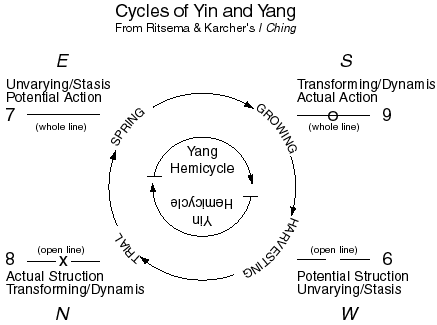 Numbers shown above correspond to numbers we use in our table of hexagrams. Compare Ritsema and Karcher's diagram above with our reality loops. MoQ Reality Loop If we compare yin and yang cycles to MoQ, we see similarities between DQ and North/South. Our favorite comparative heuristic here is Actual Action (South) as pure DQ changing existing SQ, and we see Actual Struction as DQ forming/creating new SQ. East and West then correspond to new SQ and changing SQ respectively. (This is only one of many possible interpretations. We also see a quantum loop in Tao's two hemicycles, and a latching process which transforms dynamic vacuum energy nonactuality into static actuality.) If you look at a Tao symbol like this one: 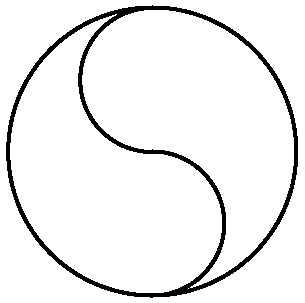 You may call one side 'yin' and its c¤mplement 'yang.' From our MoQ, Quantonic, quantum perspective, what is problematic with this Tao symbol? Let's make a list:
|
||||||||||||||||||||||||||||||||||||||||
|
One final note. Niels Bohr, father of early quantum theory, used a Tao symbol as foundation for his coat of arms with words "contraria sunt complementa" engraved around Tao. (Note his classical insistence on 'opposite' in his use of 'contraria.' In modern quantum science, we now know that we should put these more quantum words in Bohr's mouth: "There are n¤ 'classical' opposites. There are n¤ classical objects. C¤mplementarity is n¤t classical. There are only quantons. Quantons are quantum c¤mplementary.") That's our answer folks! That's what all this (reality) has to do with yin and yang! Why? We do not know! Thanks for reading, and thanks to those who took time to answer August, 1999's QQ&A. Doug. |
